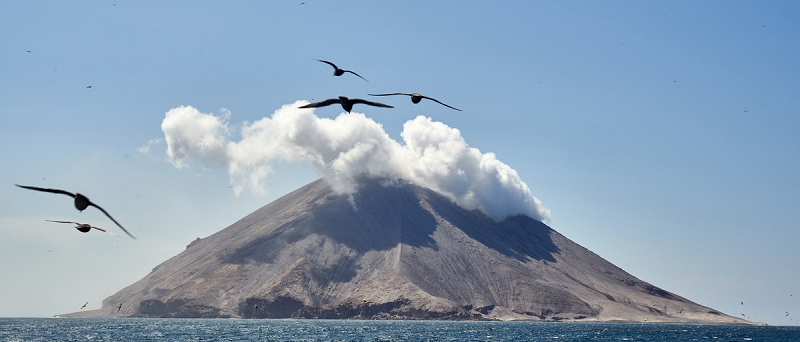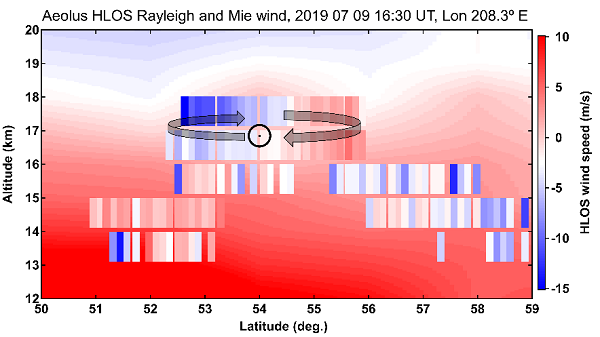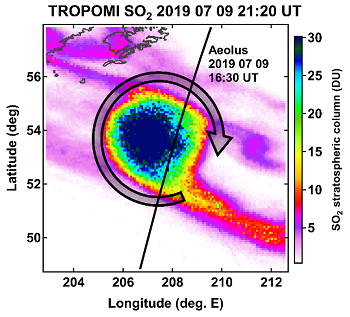- Learn & Discover
- ESA’s wind mission helps inves...
ESA’s wind mission helps investigate the nature of volcanic plumes
07 Feb 2023

An analysis that drew on wind profiles from ESA’s Aeolus mission has resulted in an unexpected discovery concerning the structure and behaviour of plumes emanating from the eruption of the Raikoke volcano in 2019.
Scientists used these data – along with observations from Copernicus Sentinel-5P – to reveal a swirling stratospheric mass of sulphur dioxide and other volcanic emissions that circled the globe three times and ascended to an altitude of some 27 km through the radiative heating of ash.
Such self-containing and long-lived anticyclonic structures have long been associated with large wildfires, but stable volcanic plumes are seldom reported and only form in certain conditions, according to the study’s authors.
The findings – which were published in Scientific Reports – have important implications for the study of the transport of volcanic emissions and their stratospheric residence time, as well as the atmospheric radiation balance.
The eruption of Raikoke – which is located on an uninhabited island in the northwest Pacific – in June 2019, was one of the most explosive volcanic events of the last three decades. It resulted in the injection of huge amounts of ash and sulphur dioxide into the upper atmosphere.
Thanks to data delivered by Copernicus Sentinel-5P’s TROPOspheric Monitoring Instrument (TROPOMI), scientists were able to determine that the volcano’s sulphur dioxide plume had clustered into distinct structures in the 72 hours following the eruption.
One of these plumes exhibited remarkable stability and its shape and path were tracked for months using several satellite sensors.

High-resolution TROPOMI measurements showed that the plume had a distinctive circular formation, which indicated the presence of rotative motion. In addition, TROPOMI – along with the CALIOP sensor onboard NASA’s CALIPSO mission – confirmed the presence tailing, which is another sign of anticyclonic motion that is often seen in wildfire plumes.
Jos de Laat, researcher at the Royal Netherlands Meteorological Institute and study co-author, says, “By enabling us to identify the shape of the plumes, high-resolution satellite observations provided evidence of the structure’s anticyclonic characteristics. However, direct and unequivocal proof for this was provided by ESA’s Aeolus mission.”
Part of ESA’s Earth Explorers programme, Aeolus carries one sensor – called the Atmospheric Laser Doppler Instrument (ALADIN) – that delivers complete vertical profiles of the wind in the lowermost 30 km of Earth’s atmosphere.
The sensor was developed to deliver data to improve weather forecasting models, but its unique observations are now also used to investigate many other processes and phenomena in the atmosphere, including swirling stratospheric plumes.

ALADIN can measure the speed of winds sweeping across clear skies, as well as within light aerosol layers and clouds. This enabled scientists to compare air movements inside the structure with the background winds that surround it.
The orbital plane of Aeolus ran over the structure several times in the months after the eruption, and wind patterns were identified that provided clear evidence of anticyclonic motion within the plume. The phenomenon was termed a vorticized volcanic plume.
These findings were supported by several other data sources, including ERA5, which is a reanalysis dataset developed by the European Centre for Medium Range Weather Forecasts.
It was reported that the formation of vorticized volcanic plumes only occurs in certain circumstances; for instance, the eruption needs to be strong enough to inject emissions into the stratosphere, it needs to be rich in ash to facilitate radiative heating, and it must occur in mid or high latitudes where plumes are more likely to rotate and form self-containing structures.

In addition, the plumes are more likely to persist during local summertime, when the stratosphere is less dynamically active.
Sergey Khaykin, researcher at the French National Centre for Scientific Research (CNRS) LATMOS laboratory and study lead author, says, “This project provides a great demonstration of the wide array of data provided by European Earth observation missions, as well as what can be achieved though the combined analysis of data from different sensors.
“We look forward to continuing to use these data to further investigate the formation of volcanic plumes, and their impact on the stratosphere.”
Future areas of research could include developing mathematical models of the formation and movement of volcanic plumes, investigating the effect of these plumes on the ozone layer, and much more.